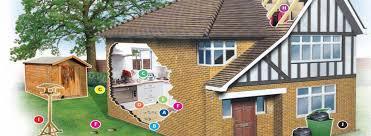
Homeowners encounter many kinds of pests who would like to dwell inside their homes. These come in many sizes. It helps to know something about these animals so that you can predict their behavior. Thwarting their goals is the way to send them looking elsewhere for food or shelter. Let's look at a few broad groups of pests:
Termites, Ants, Etc.
Termites live on, and in, the wood that forms many houses. Their presence is a safety issue because they weaken support beams. They usually appear from a source near the building, so store woodpiles away from the house. Ants might be large carpenter ants, small 'sugar ants', or another kind. Keeping floors swept and food sources tightly closed will discourage insects. If carpenter ants build a colony nearby, commercial extermination products often help.
Reptiles and Amphibians
An unfinished basement is the usual way for snakes, toads, and salamanders to slip inside a house. If you can't finish your basement, then seal cracks and holes. If there are insects present in the home, this will attract the animals that enjoy eating them. This could be considered an advantage, but probably not.
Scorpions and Spiders
These can be dangerous to the health and safety of family members. Not only do residents of the Southwest face scorpions, but spiders like the Yellow Sac Spider are found throughout North America. Their bite can cause serious illness and scarring. Sweeping away webs discourages them. Keep storage to a minimum. This reduces hiding places for spiders, scorpions, and their food sources.
Mice and Rats
Mice and rats fit through cracks that don't look big enough to use. Make sure doors fit tightly in their frames. Seal the entrances to the garage with strips and other methods that keep animals from seeking shelter. Keep foods put away and store clothing, food, and other items in tight plastic boxes. Many commercial traps are available. Experiment to find which ones work best. Mice also learn to avoid them, so you may need to switch methods.
Squirrels, Raccoons, and Others
These animals appreciate an attic with a large enough hole that provides access to shelter and a cozy place to raise their young. Inspect your home regularly for holes in attics, basements, or under porches. Farm supply stores carry animal traps.
Some prevention methods work across species. Stop leaks that provide a water source. Store items in sturdy boxes. Clear away outside debris and keep vegetation cut back. Seal cracks and holes. Animal behavior is seasonal, so infestations usually occur during extreme temperatures or mating season. Finally, consult a professional exterminator to solve these problems for you.

Tom James,
